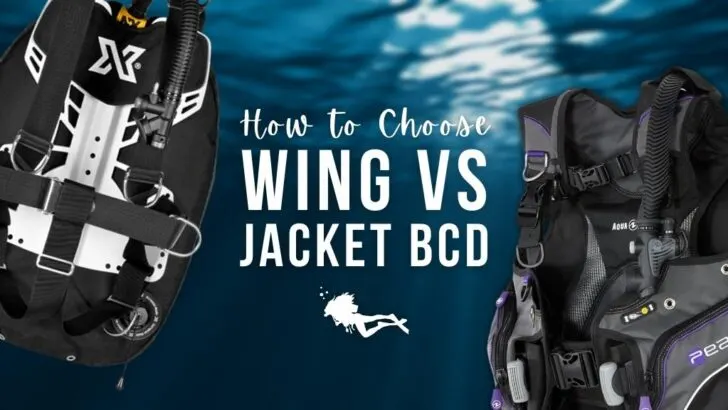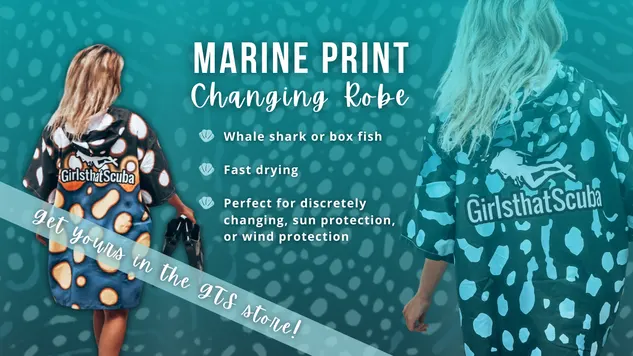Just like buying any piece of scuba diving equipment, choosing a BCD can be a challenge. BCDs have evolved a lot over the time we’ve been exploring underwater. There’s so much choice out there, and an ever-growing number of divers are opting for a backplate and wing setup! So which comes out on top when choosing a wing vs jacket BCD?
We’re here to help you work out what will be the best choice for your personal diving needs. We share the differences between jacket and wing BCDs, giving you an overview of each style. Let’s get into the pros and cons of jackets and wings! We’ll also tell you the best in each category as recommended by our GTS community.
Want to know our community’s favourite BCD models? Check them out here!
Jacket BCDs
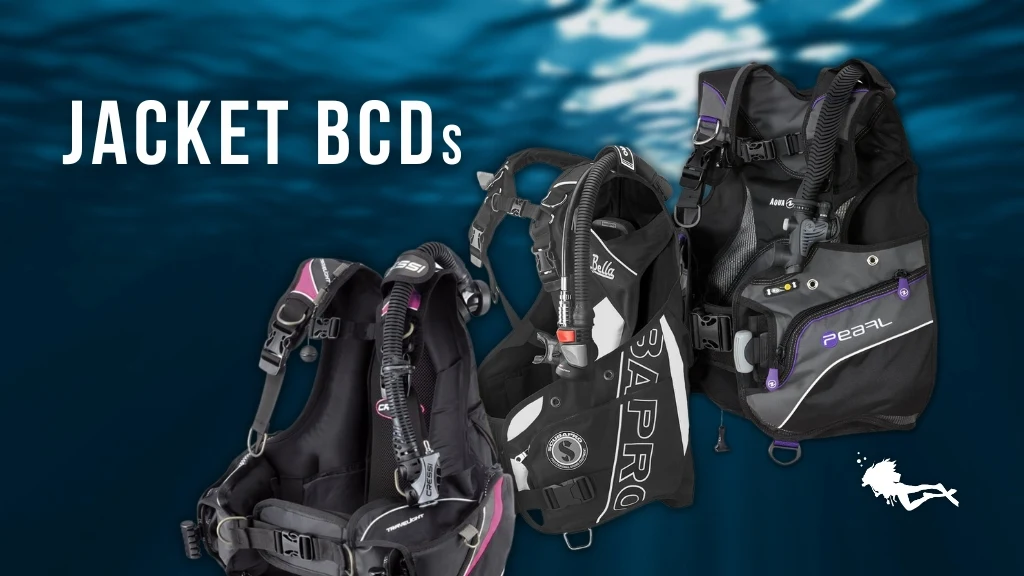
You’ll likely be familiar with a jacket style BCD, as it’s probably what you used when you first learned to scuba dive. Modern jacket style BCDs are designed to wrap around and hug the body. The bladder (the part which inflates) fills the entirety of the jacket so that the BCD inflates on all sides.
Pros of a jacket BCD
First up, the familiarity of a jacket BCD makes it a default choice. Whilst there are some differences between models, you will mostly know where to find your pockets, D-rings, inflator hose. Most importantly, you’ll also know where to find the releases.
If you learned to dive in a jacket, your buoyancy in a jacket should also be familiar. You should easily be able to add and release air to maintain a good position. You’ll also know which dump valves are easiest to use in different positions during your dive.
In recent years jacket BCDs have also been specifically designed to accommodate women’s bodies. These small adaptations – including shorter backplates, wider shoulder straps, additional padding, and more form-fitting waistbands – make modern women-specific jacket BCDs incredibly comfortable.
You will also find that in jacket BCDs there’s a lot more storage than a wing. Jacket BCDs often feature large pockets on the sides to carry items such as spare equipment, DSMBs, or torches. This makes them a great choice for tasks like scientific diving and instructing.
Cons of a jacket BCD
With all of these snazzy features and comfortable padding comes probably the biggest drawback of a jacket-style BCD – the weight. Unless you’re choosing a travel-specific model, jacket BCDs can be extremely heavy and bulky in comparison to backplate and wings. Being larger means they’re more difficult to pack up, so they’re not the best for travelling divers. Also, they can often take much longer to dry in between dives.
A jacket BCD can also be limiting depending on your future diving ambitions. If you see yourself moving into technical diving, a backplate and wing will last much longer in your diving career!
Wing BCDs
With the increasing popularity of technical diving, many scuba divers are opting for a backplate and wing setup earlier on in their diving. You’ll notice we use the words “system” and “setup” a lot when discussing wing-style BCDs. This is because they’re often less off-the-shelf and can be built up and customised from their individual components.
A backplate and wing system consists of three elements – a wing or bladder, a backplate, and a harness or webbing.
- The backplate holds your cylinder(s) in a solid position on your back.
- The bladder or wing inflates, filling with air to provide buoyancy.
- The webbing or harness keeps it all strapped comfortably to your body.
The most noticeable difference is that all of the inflation is on your back, as opposed to being wrapped around your body.
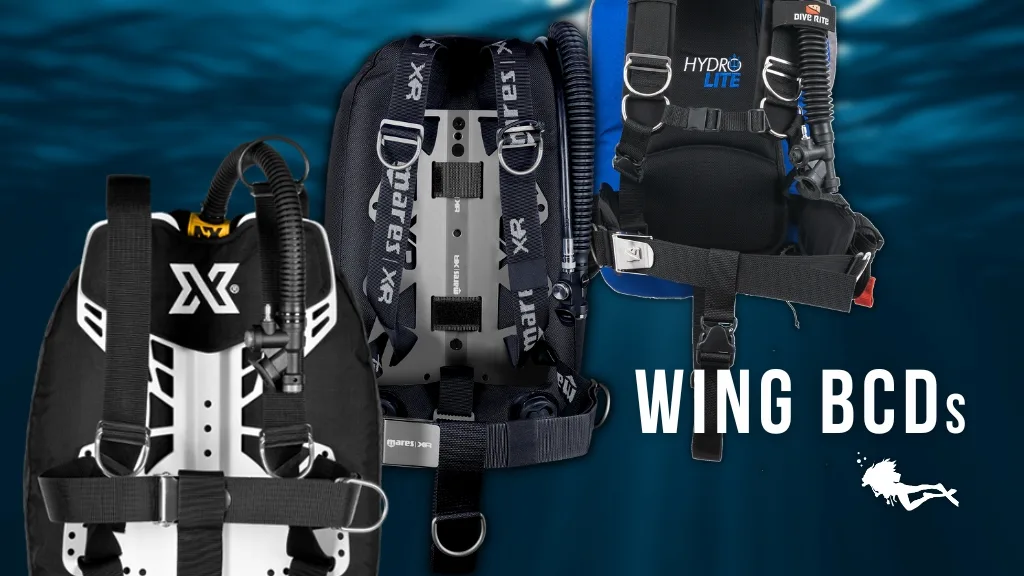
Pros of a wing BCD
The first noticable positive effect of switching to a wing system is great trim, or positioning, in the water. We should always aim to dive in a horizontal position, but jackets can hinder this positioning. With a jacket, the air moving around different parts of the bladder can cause us to roll around in the water. This is even worse if the jacket isn’t well-fitted. With a wing, the heavier backplate places weight in the correct place to encourage a more head-down position.
As well as giving you great positioning, a backplate and wing is an extremely customisable system. This can offer a completely personalised setup. You can ensure you’re comfortable underwater by making the harness a perfect fit for your body.
It can also be a surprisingly affordable option. When setting up your own system you’re not restricted to sticking to one brand for all the elements. This means you can get great value by mixing and matching different parts from different brands.
The stripped-back construction of a wing system means that they can be extremely lightweight. This makes them a great option for travel, although this will depend on what material you choose for your backplate. Backplates are ordinarily made from steel or aluminium, with some newer materials such as carbon fiber growing in popularity. Aluminium is a fantastic lightweight yet affordable choice if you’re building a travel system.
Finally, the greatest strength of a backplate and wing setup is probably the biggest drawback of a jacket BCD. As you grow as a diver and choose to search out new adventures, your wing system can grow alongside you.
The modular setup means that you can switch out various parts. This could be to accommodate double or twin cylinders, change backplates for travel or fresh vs salt water needs, or to switch to a bigger bladder with larger lift capacity for drysuit diving. If there’s any possibility of pursuing tech diving in your future, you should definitely be considering a wing.
Cons of a wing BCD
If you’ve found a trusty jacket BCD over the years, you may be hesitant to move away from the comfort. The padding and the “hug”-like effect of a strap wrapping around your waist can become familiar! A stripped back harness will feel different, and some find it much less comfortable. However, for other divers, the freedom that comes with having all of the inflation behind you makes for a much more comfortable feeling, so your mileage may vary.
Another major difference is the feel of a wing on the surface. Many people who are new to wings complain that they feel forced forward on the surface and cannot comfortably “sit back” in the water. If you’re someone who spends a lot of time waiting for boats on the surface, this could impact you.
Despite this, you will adjust to this over time. You’ll learn quickly what level of inflation and body positioning works best to keep you comfortable on the surface.
The lack of storage may also be a shock if you’re used to a jacket. Wings do not come equipped with pockets, so anything you need to carry will have to be cleverly clipped to D-rings instead. Alternatively, some manufacturers make cargo pockets which can be attached to your webbing.
For cold water divers there’s the option of pockets built into drysuits. Tropical divers can add tech shorts in order to gain back some storage space if necessary.
Want to learn more about switching to a backplate and wing? Check out Girls that Scuba member Emma’s story!
Hybrid BCDs
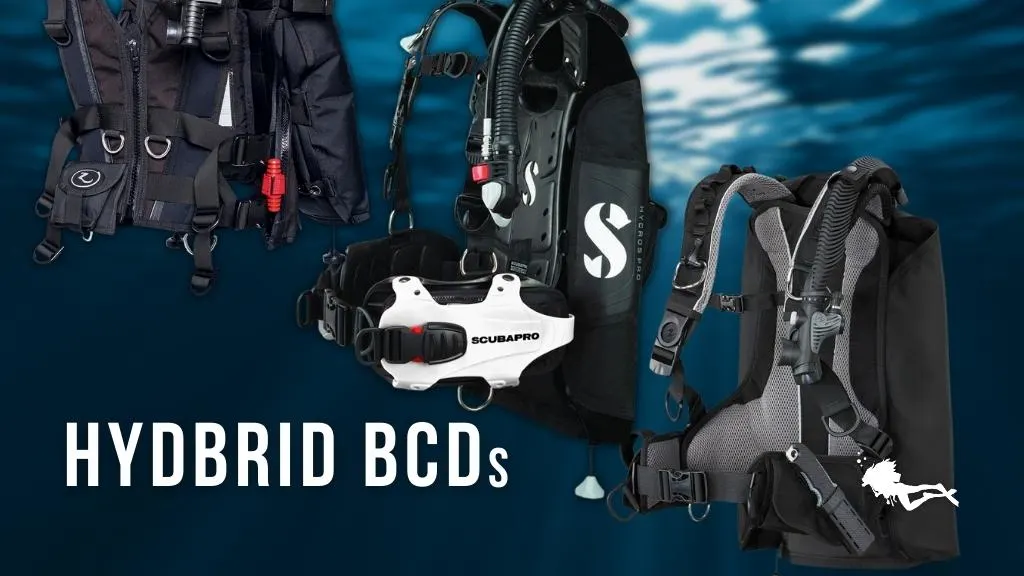
If you’ve found yourself feeling like you need something between the two styles, the dive industry has got you covered. Many BCDs on the market now are a hybrid style. These fuse the best features of both jackets and wings into one.
These styles are usually back-inflate, offering great trim and positioning, yet still have the jacket benefits of lots of storage and increased comfort. Our favourite jacket and hybrid BCDs can be found in our run down of the best women’s BCDs!
So what type of BCD will you be opting for next? Tag us on Instagram @girlsthatscuba to show off your new setup!

